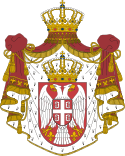- Constitutional Court of Serbia
-
Constitutional Court of the Republic of Serbia
Уставни суд Републике СрбијеEstablished 9 April 1963 Jurisdiction Serbia Location Belgrade, Nemanjina str. 26 Composition method Parliament selection (5 members)
Supreme Court selection (5 members)
Presidental selection (5 members)Authorized by Constitution Judge term length 9 years Number of positions 15 Website www.ustavni.sud.rs President Currently Dragiša Slijepčević Since February 3, 2011 Serbia 
This article is part of the series:
Politics and government of
SerbiaConstitutionParliamentJudiciaryDivisionsLocal government
The Constitutional Court of the Republic of Serbia (Serbian: Уставни суд Републике Србије; Ustavni sud Republike Srbije) is the court authorized to perform judicial review in the Republic of Serbia. It rules on whether the laws, decrees or other bills enacted by the Serbian authorities are in conformity with the Constitution. It is not considered as part of the judicial branch, but a court sui generis. The Constitutional Court is authorized by the Constitution itself and the Law on the Constitutional Court.[1]
The seat of the Constitutional Court is in Belgrade and it is consisted of 15 judges, one of them being President of the Court.[2]
Contents
History
The Constitutional Court of the Socialist Republic of Serbia (then part of SFR Yugoslavia) was established on 9 April 1963 as an independent body of the Republic and desigated to protect constitutionality and legality in accordance with the Constitution and within the framework of the rights and duties proscribed by the 1963 Constitution of SR Serbia. The Constitutional Law of Serbia, enacted on 25 December 1963, defined jurisdiction and adjudications before the Constitutional Court and legal effects of its decisions in a more specific manner.
The Constitutional Court of Serbia commenced its work on 15 February 1964. The Constitutional Court has upon proclamation of the 1990 Constitution of Serbia acted within the framework of absence of division of powers, where the Parliament was the highest body of state power. The Constitutional Court has through its presence and work contributed to the importance and contribution in preservation of the constitutional principles and legality.[3]
Composition
The Constitutional Court is consisted of 15 judges. Five of them are elected by the President of Serbia, five by the National Assembly, and five are elected at the General Session of the Supreme Court of Cassation. Judges are elected to the 9-year term. The candidates have to be accomplished lawyers of at least 40 years of age and with at least 15 years of experience in jurisprudence. One person can be elected to the Court a maximum of two times. After the election, the judges take oath before the President of the National Assembly.
The term of the Constitutional Court judge ends after 9 years since the election, or by resignation, by retirement or by impeachment. A Constitutional Court judge may not perform any other public office or any other job at all, except for being a professor at the Law School of one of the universities in Serbia. A Constitutional Court judge enjoys immunity from prosecution.[2]
Composition as of 2010[update] (year of election given in the parenthesis):[4]
- Dragiša B. Slijepčević, Phd, President (2007)
- Marija Draškić, PhD, Deputy President (2007)
- Olivera Vučić, PhD (2007)
- Bratislav Đokić (2010)
- Goran P. Ilić, PhD(2010)
- Vesna Ilić-Prelić (2007)
- Agneš Kartag-Odri, PhD (2007)
- Katarina Manojlović-Andrić (2007)
- Milan Marković (2010)
- Bosa Nenadić, PhD (2007)
- Milan Stanić (2010)
- Dragan M. Stojanović, PhD (2007)
- Tomislav B. Stojković (2010)
- Sabahudin Tahirović (2010)
- Predrag Ćetković (2007)
Former presidents
Presidents of the Constitutional Court between 1971 and 2007 were:[5]
- Petar Relić (1963–1971)
- Jovan Đorđević (1971–1979)
- Najdan Pašić (1980–1984)
- Radoslav Ratković (1984–1986)
- Đurđe Seničić (1987–1988)
- Miodrag Bogdanović (1988–1990)
- Balša Špadijer (1990–1996)
- Ratko Butulija (1996–2001)
- Slobodan Vučetić (2002–2007)
- Bosa Nenadić (2007-2010)
Library of the Constitutional Court
Library of the Constitutional Court started to work after the Court has been established. According to the profile of its collections, the Library of the Constitutional Court belongs to the family of specialized law libraries. The library is in charge of collecting, storing, cataloguing and offering for use literature from different branches of law with special regard to constitutional legislation. The Library is in possession of a large collection of monographs, serial publications, collections of papers, and it also has an electronic database of legal acts.
The Constitutional Court Library owns a valuable collection of legal acts issued in the late 19th and early 20th centuries. The Library cooperates with the head office of Belgrade City Library, National Library of Serbia and other libraries of similar profile.[6]
See also
- Constitutional court
- Supreme Court of Serbia
- Constitution of Serbia
- Constitutionalism
- Rule According to Higher Law
References
This article incorporates text from the Constitutional Court of Serbia official site ([1]), which is in the public domain, because it is a law, decree, regulation or official material of a Republic of Serbia state body or a body performing public functions, under the terms of Article 6, Paragraph 2 of Serbian copyright law. See Copyright.
- ^ Constitutional Court of Serbia official site: Law on the Constitutional Court
- ^ a b Constitutional Court of Serbia official site: Election, appointment and termination of office (Serbian)
- ^ Constitutional Court of Serbia official site: The history of the court from its foundation
- ^ Constitutional Court of Serbia official site: Composition
- ^ Constitutional Court of Serbia official site: Former Presidents
- ^ Constitutional Court of Serbia official site: The Library of the Constitutional Court of the Republic of Serbia
External links
Categories:- Constitutional courts
- Serbian law
Wikimedia Foundation. 2010.
